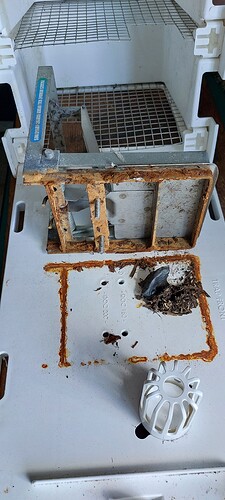We have just been given a doc200 Trapinator and a large sachet of GN blood lure.
Can you tell me what is the best setup for the lure and an egg please. Any thoughts on a fresh egg, old/rotten egg or plastic egg please?
The trap looks to be plated or powder coated and the lower frame was not in great condition – I have cleaned off the rust, rust killed it and zinc sprayed it – so should be good for a new life. I have always purchased stainless doc200/250s and can now see the advantages.
I use GN blood lure in and on my Trapinators - a smear about 1/4 teaspoon at the front and the rear, just inside the entrance, in front of the baffle, and inside the egg-mount depression. FYI, the blackbirds where I trap are quite fond of GN blood lure. I’ve killed a number of them over the years with it, so bear that in mind.
I’m a big proponent of using multiple lures, so adding some mayo, PB, or Nutella to the blood lure should make the Trapinator get noticed faster.
For the past few years, I’ve used both hens’ eggs, plastic eggs, and golf balls, and I haven’t noticed a real difference. I think it depends on whether or not an egg is the only lure being used. You would be wise to use hens’ eggs for their smell, in that scenario. With 1 or more scent lures inside a tunnel, I think that using hens’ eggs would likely be a waste of money and effort.
It’s definitely worth the money to buy stainless steel DOC traps, IMO.
Do you know how to calibrate DOC traps? Before the traps see any action, it would be a good idea to test it. There are some videos on Youtube that show you how to do it. There are sets of small weights that you can buy online to make sensitivities more accurate.
Cheers.
